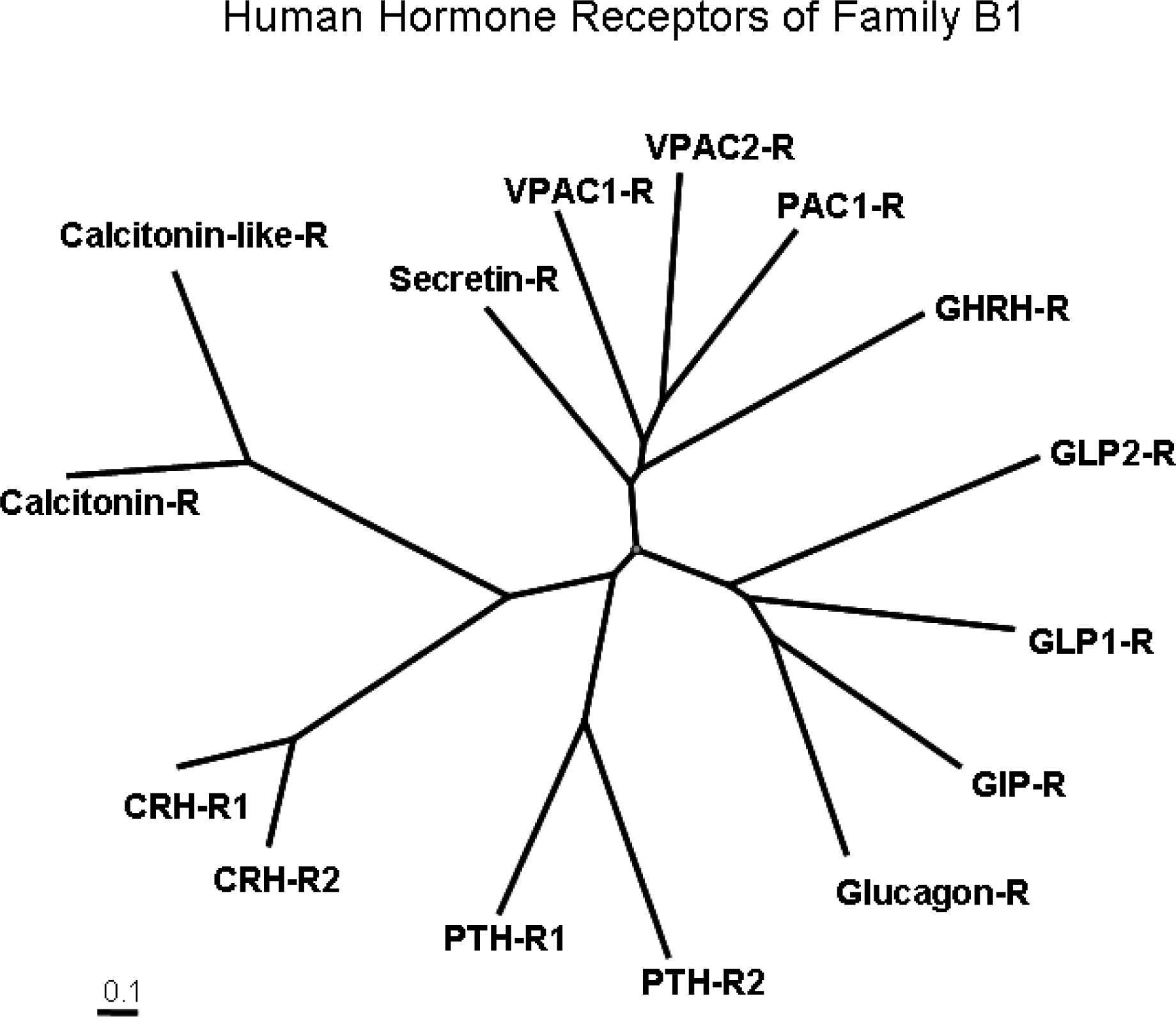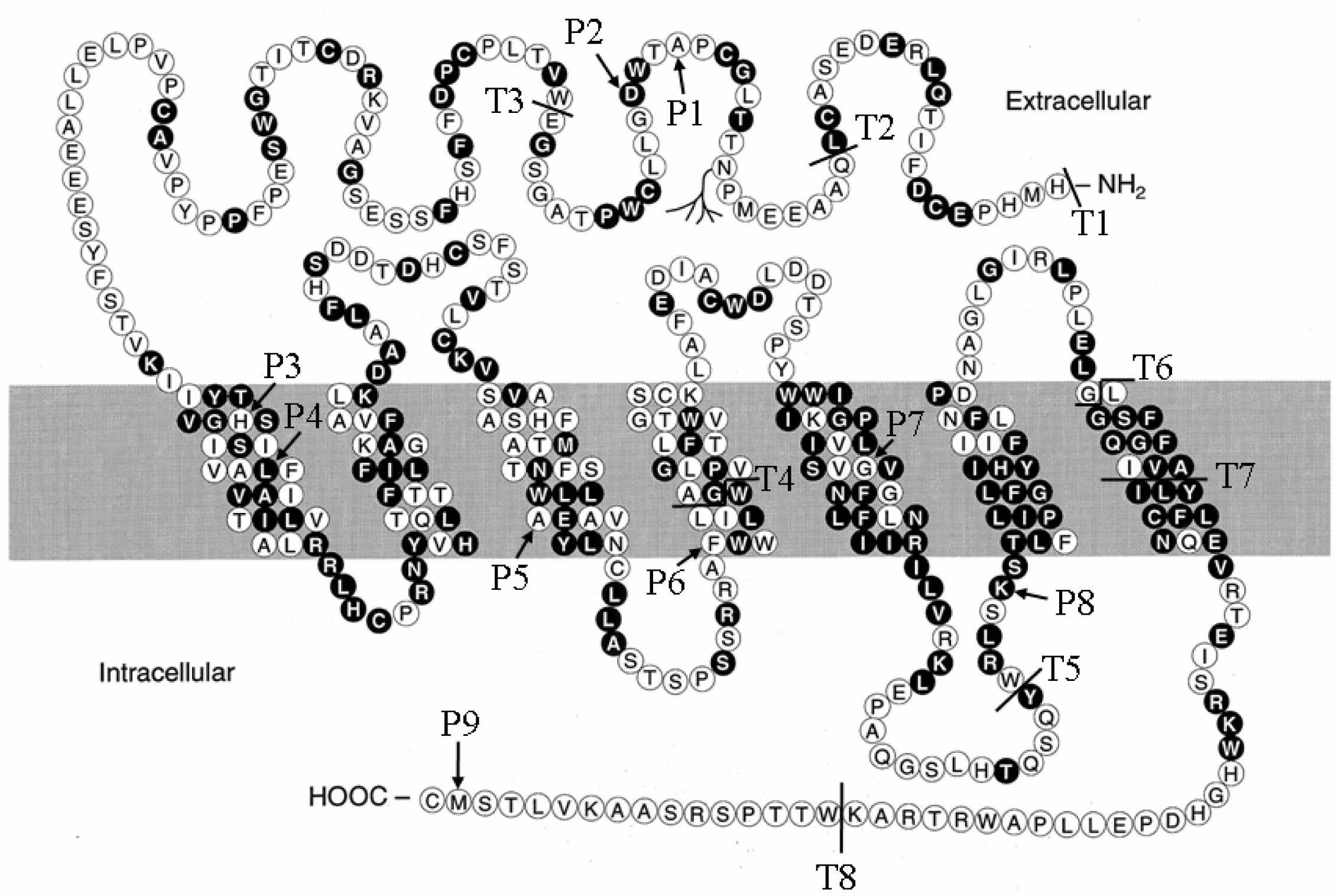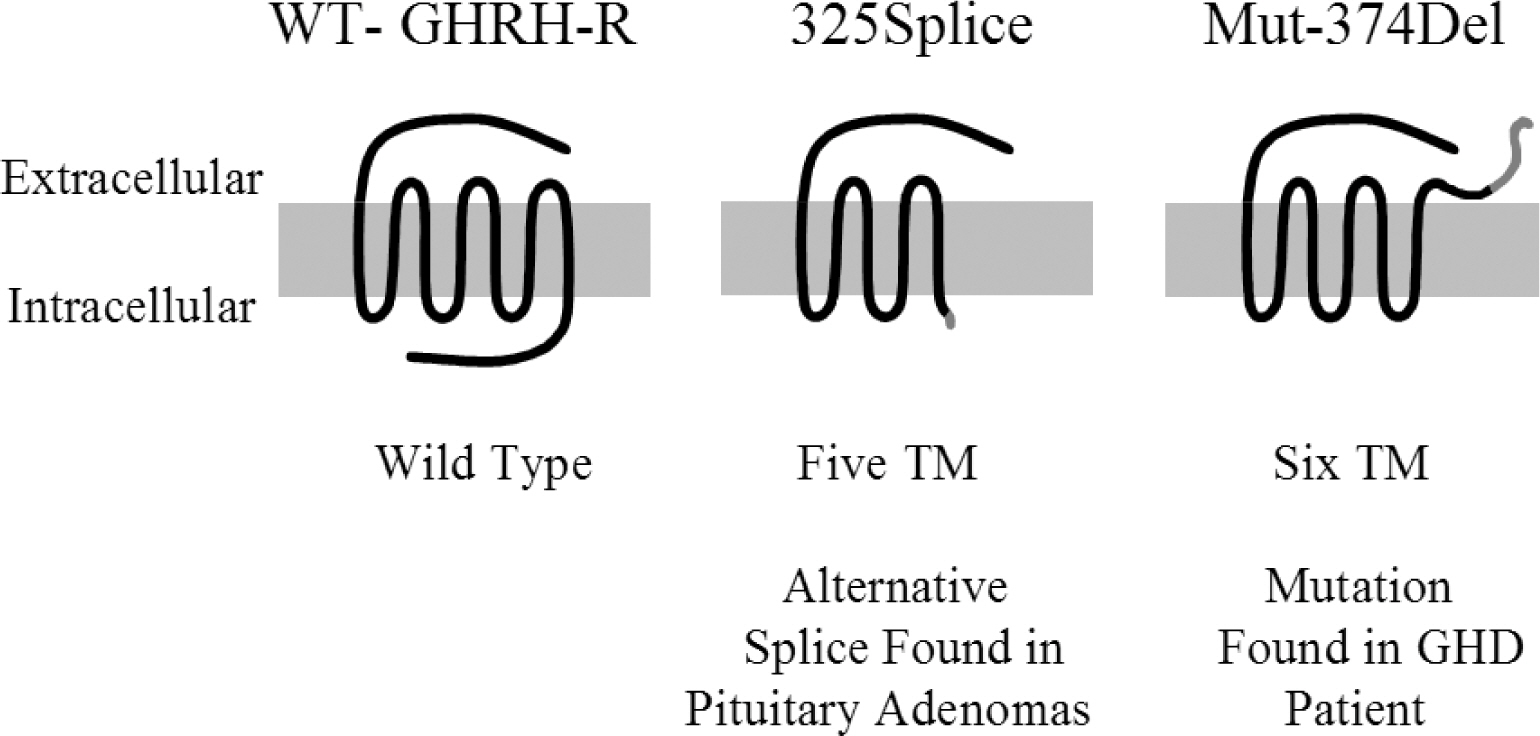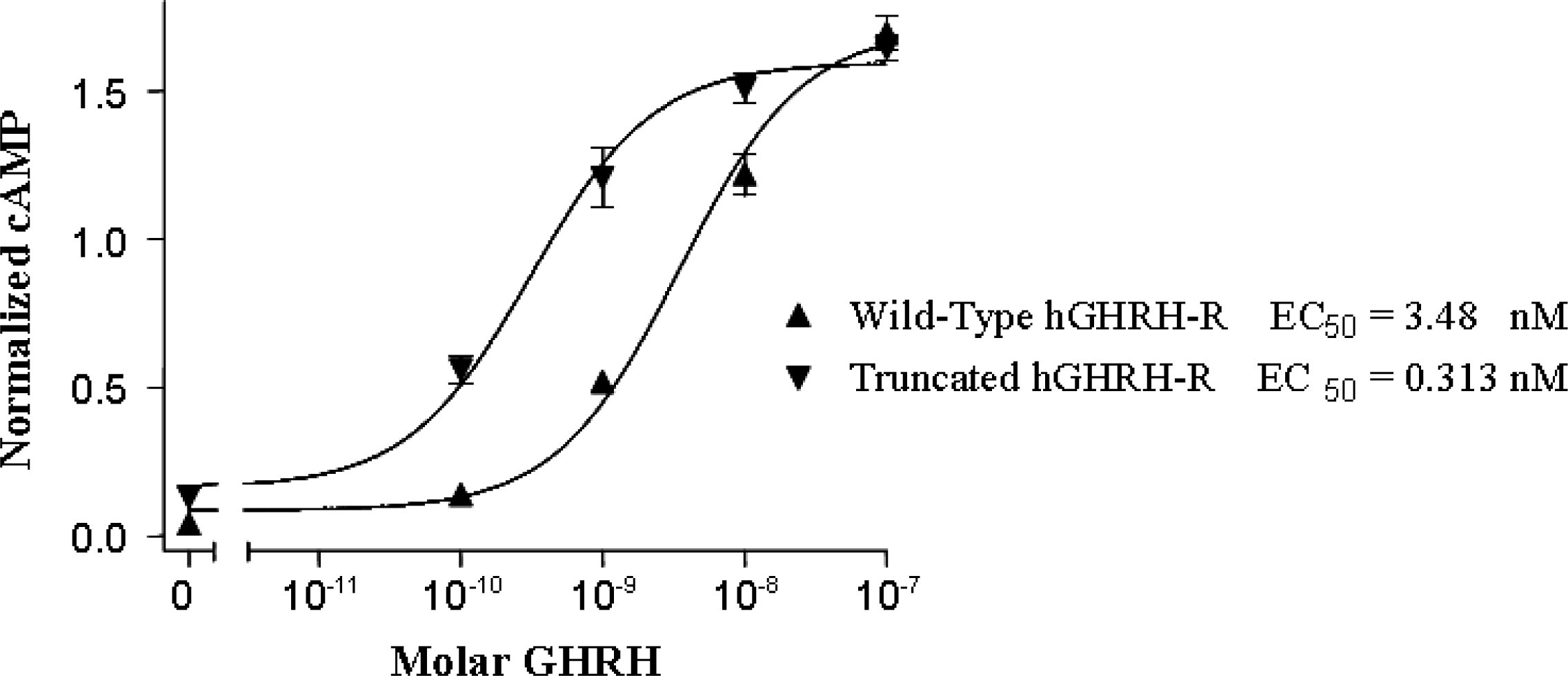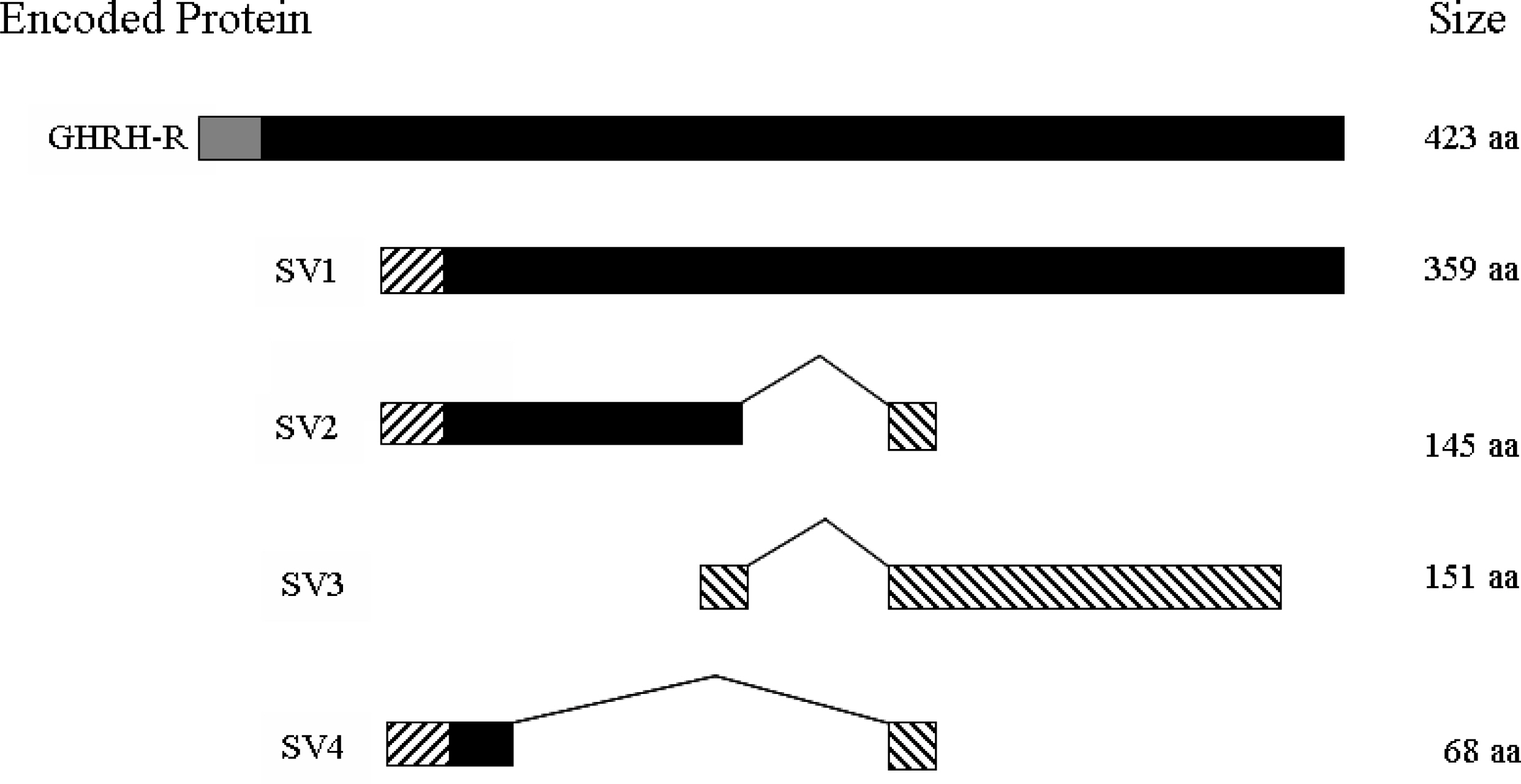J Korean Soc Endocrinol.
2006 Jun;21(3):173-183. 10.3803/jkes.2006.21.3.173.
Current Research on the Structure and Function of the Growth Hormone Releasing Hormone Receptor
- Affiliations
-
- 1Division of Endocrinology, University of Virginia Health System, USA.
- KMID: 2200728
- DOI: http://doi.org/10.3803/jkes.2006.21.3.173
Abstract
- Growth hormone releasing hormone receptor (GHRH-R) is a family B1 G-protein coupled receptor found predominantly on pituitary somatotrophs. In the adults it is required for the normal synthesis and release of growth hormone (GH) from the pituitary. During development it is required for the normal proliferation and maturation of somatotrophs within the pituitary. Mutations of this receptor in mouse and man are associated with GH deficiency, short stature and pituitary hypoplasia. This signaling system plays important roles in growth and development, metabolism of muscle and fat, and is implicated in the regulation of cardiac and immune function, wound healing, tumor growth and the aging process. Current areas of active research discussed here include: studiesof the structure of the receptor binding site and its interaction with GHRH, alternative splice variants of the GHRH-R which appear to promote tumor proliferation, truncated receptor isoforms that act as dominant negative inhibitors of wild type receptor, and the unclear physiologic role of the GHRH system in birds and fishes.
MeSH Terms
Figure
Reference
-
References
1. Gaylinn BD, Harrison JK, Zysk JR, Lyons CE, Lynch KR, Thorner MO. Molecular cloning and expression of a human anterior pituitary receptor for growth hormone-releasing hormone. Mol Endocrinol. 7:77–84. 1993.
Article2. Mayo KE. Molecular cloning and expression of a pituitary-specific receptor for growth hormone -releasing hormone. Mol Endocrinol. 6:1734–1744. 1992.3. Frohman LA, Jansson JO. Growth hormone-releasing hormone. Endocr Rev. 7:223–253. 1986.
Article4. Mayo KE, Miller T, DeAlmeida V, Godfrey P, Zheng J, Cunha SR. Regulation of the pituitary somatotroph cell by GHRH and its receptor. Recent Prog Horm Res. 55:237–266. 2000.5. Goth MI, Lyons CE, Canny BJ, Thorner MO. Pituitary adenylate cyclase activating polypeptide, growth hormone (GH)-releasing peptide and GH-releasing hormone stimulate GH release through distinct pituitary receptors. Endocrinology. 130:939–944. 1992.
Article6. Cella SG. De Gennaro Colonna V, Locatelli V, Bestetti GE, Rossi GL, Torsello A, Wehrenberg WB, Muller EE: Somatotropic dysfunction in growth hormone-releasing hormone-deprived neonatal rats: effect of growth hormone replacement therapy. Pediatr Res. 36:315–322. 1994.7. Lin SC, Lin CR, Gukovsky I, Lusis AJ, Sawchenko PE, Rosenfeld MG. Molecular basis of the little mouse phenotype and implications for cell type-specific growth. Nature. 364:208–213. 1993.
Article8. Godfrey P, Rahal JO, Beamer WG, Copeland NG, Jenkins NA, Mayo KE. GHRH receptor of little mice contains a missense mutation in the extracellular domain that disrupts receptor function. Nat Genet. 4:227–232. 1993.
Article9. Wajnrajch MP, Gertner JM, Harbison MD. Chua SC Jr, Leibel RL: Nonsense mutation in the human growth hormone-releasing hormone receptor causes growth failure analogous to the little (lit) mouse. Nat Genet. 12:88–90. 1996.10. Baumann G, Maheshwari H. The Dwarfs of Sindh: severe growth hormone (GH) deficiency caused by a mutation in the GH-releasing hormone receptor gene. Acta Paediatr Suppl. 423:33–38. 1997.
Article11. Maheshwari HG, Silverman BL, Dupuis J, Baumann G. Phenotype and genetic analysis of a syndrome caused by an inactivating mutation in the growth hormone-releasing hormone receptor: Dwarfism of Sindh. J Clin Endocrinol Metab. 83:4065–4074. 1998.
Article12. Netchine I, Talon P, Dastot F, Vitaux F, Goossens M, Amselem S. Extensive phenotypic analysis of a family with growth hormone (GH) deficiency caused by a mutation in the GH-releasing hormone receptor gene. J Clin Endocrinol Metab. 83:432–436. 1998.
Article13. Salvatori R, Hayashida CY, Aguiar-Oliveira MH, Phillips JA 3rd, Souza AH, Gondo RG, Toledo SP, Conceicao MM, Prince M, Maheshwari HG, Baumann G, Levine MA. Familial dwarfism due to a novel mutation of the growth hormone-releasing hormone receptor gene. J Clin Endocrinol Metab. 84:917–923. 1999.
Article14. Alba M, Salvatori R. Familial growth hormone deficiency and mutations in the GHRH receptor gene. Vitam Horm. 69:209–220. 2004.
Article15. Salomon F, Cuneo RC, Hesp R, Sonksen PH. The effects of treatment with recombinant human growth hormone on body composition and metabolism in adults with growth hormone deficiency. N Engl J Med. 321:1797–1803. 1989.
Article16. Bengtsson BA, Eden S, Lonn L, Kvist H, Stokland A, Lindstedt G, Bosaeus I, Tolli J, Sjostrom L, Isaksson OG. Treatment of adults with growth hormone (GH) deficiency with recombinant human GH. J Clin Endocrinol Metab. 76:309–317. 1993.
Article17. Sartorio A, Ortolani S, Conti A, Cherubini R, Galbiati E, Faglia G. Effects of recombinant growth hormone (GH) treatment on bone mineral density and body composition in adults with childhood onset growth hormone deficiency. J Endocrinol Invest. 19:524–529. 1996.
Article18. O’Halloran DJ, Tsatsoulis A, Whitehouse RW, Holmes SJ, Adams JE, Shalet SM. Increased bone density after recombinant human growth hormone (GH) therapy in adults with isolated GH deficiency. J Clin Endocrinol Metab. 76:1344–1348. 1993.19. Auernhammer CJ, Strasburger CJ. Effects of growth hormone and insulin-like growth factor I on the immune system. Eur J Endocrinol. 133:635–645. 1995.
Article20. Lal SO, Wolf SE, Herndon DN. Growth hormone, burns and tissue healing. Growth Horm IGF Res 10(Suppl B):S39-43. 2000.
Article21. Colao A, Marzullo P. Di Somma C, Lombardi G: Growth hormone and the heart. Clin Endocrinol. 54:137–154. 2001.22. Napoli R, Guardasole V, Matarazzo M, Palmieri EA, Oliviero U, Fazio S, Sacca L. Growth hormone corrects vascular dysfunction in patients with chronic heart failure. J Am Coll Cardiol. 39:90–95. 2002.
Article23. Lange M, Thulesen J, Feldt-Rasmussen U, Skakkebaek NE, Vahl N, Jorgensen JO, Christiansen JS, Poulsen SS, Sneppen SB, Juul A. Skin morphological changes in growth hormone deficiency and acromegaly. Eur J Endocrinol. 145:147–153. 2001.
Article24. E Van Cauter, L Plat, G Copinschi. Interrelations between sleep and the somatotropic axis. Sleep. 21:553–566. 1998.25. Beshyah SA, Freemantle C, Shahi M, Anyaoku V, Merson S, Lynch S, Skinner E, Sharp P, Foale R, Johnston DG. Replacement treatment with biosynthetic human growth hormone in growth hormone-deficient hypopituitary adults. Clin Endocrinol. 42:73–84. 1995.
Article26. Murray RD, Darzy KH, Gleeson HK, Shalet SM. GH-deficient survivors of childhood cancer: GH replacement during adult life. J Clin Endocrinol Metab. 87:129–135. 2002.
Article27. Vance ML. Nutrition, body composition, physical activity and growth hormone secretion. J Pediatr Endocrinol 9(Suppl 3). 299–301. 1996.28. Johannsson G, Svensson J, Bengtsson BA. Growth hormone and ageing. Growth Horm IGF Res 10(Suppl B):S25-30. 2000.
Article29. Billestrup N, Swanson LW, Vale W. Growth hormone-releasing factor stimulates proliferation of somatotrophs in vitro. Proc Natl Acad Sci USA. 83:6854–6857. 1986.
Article30. Csernus V, Schally AV, Groot K. Antagonistic analogs of growth hormone releasing hormone (GHRH) inhibit cyclic AMP production of human cancer cell lines in vitro. Peptides. 20:843–850. 1999.
Article31. Kineman RD. Antitumorigenic actions of growth hormone-releasing hormone antagonists. Proc Natl Acad Sci USA. 97:532–534. 2000.
Article32. Kiaris H, Schally AV, Kalofoutis A. Extrapituitary effects of the growth hormone-releasing hormone. Vitam Horm. 70:1–24. 2005.
Article33. Harmar AJ. Family-B G-protein-coupled receptors. Genome Biol 2:Reviews3013.1-3013.10. 2001.34. Fredriksson R, Schioth HB. The repertoire of G-protein-coupled receptors in fully sequenced genomes. Mol Pharmacol. 67:1414–1425. 2005.
Article35. Christophe J. The VIP/PHI/secretin/helodermin/helospectin/ GRF family: structure-function relationships of the natural peptides, their precursors and synthetic analogues as tested in vitro on receptors and adenylate cyclase in a panel of tissue membranes. Martinez J, editor. Peptide Hormones as Prohormones: Processing, Biological Activity, Pharmacology pp. 211-243, Chichester [England], E. Horwood. New York: Halsted Press;1989.36. Bell GI. The glucagon superfamily: precursor structure and gene organization. Peptides 7(Suppl 1). 27–36. 1986.
Article37. Campbell RM, Scanes CG. Evolution of the growth hormone-releasing factor (GRF) family of peptides. Growth Regul. 2:175–191. 1992.38. Ishihara T, Nakamura S, Kaziro Y, Takahashi T, Takahashi K, Nagata S. Molecular cloning and expression of a cDNA encoding the secretin receptor. EMBO J. 10:1635–1641. 1991.
Article39. Lin C, Lin SC, Chang CP, Rosenfeld MG. Pit-1-dependent expression of the receptor for growth hormone releasing factor mediates pituitary cell growth. Nature. 360:765–768. 1992.
Article40. Andrews S, Dubbelde C, Ryan E. The sequence of Homo sapians PAC clone DJ0877J02, GenBank accession No AC005155. US National Center for Biotechnology Information, National Library of Medicine/National Institutes of Health at. http://.ncbi.nlm.gov/. 1998.41. Mayo KE, Miller TL, DeAlmeida V, Zheng J, Godfrey PA. The growth-hormone-releasing hormone receptor: signal transduction, gene expression, and physiological function in growth regulation. Ann N Y Acad Sci. 805:184–203. 1996.42. Palczewski K, Kumasaka T, Hori T, Behnke CA, Motoshima H, Fox BA, Le Trong I, Teller DC, Okada T, Stenkamp RE, Yamamoto M, Miyano M. Crystal structure of rhodopsin: A G protein-coupled receptor. Science. 289:739–745. 2000.
Article43. Dias JA. Van Roey P: Structural biology of human follitropin and its receptor. Arch Med Res. 32:510–519. 2001.44. Campbell RM, Bongers J, Felix AM. Rational design, synthesis, and biological evaluation of novel growth hormone releasing factor analogues. Biopolymers. 37:67–88. 1995.
Article45. Robberecht P, Coy DH, Waelbroeck M, Heiman ML. de Neef P, Camus JC, Christophe J: Structural requirements for the activation of rat anterior pituitary adenylate cyclase by growth hormone-releasing factor (GRF): discovery of (N-Ac-Tyr1, D-Arg2)-GRF (1-29)-NH2 as a GRF antagonist on membranes. Endocrinology. 117:1759–1764. 1985.46. Coy DH, Hocart SJ, Murphy WA. Human growth hormone-releasing hormone analogues with much improved in vitro growth hormone-releasing potencies in rat pituitary cells. Eur J Pharmacol. 204:179–185. 1991.
Article47. DeAlmeida VI, Mayo KE. Identification of binding domains of the growth hormone-releasing hormone receptor by analysis of mutant and chimeric receptor proteins. Mol Endocrinol. 12:750–765. 1998.
Article48. Gaylinn BD, Lyons CE, Thorner MO. Mapping of the GHRH receptor binding site by photoaffinity crosslinking from different residues of GHRH. In the 79th Annual Meeting of Endocrine Society. Minneapolis, USA. 1997.49. Grace CR, Perrin MH, DiGruccio MR, Miller CL, Rivier JE, Vale WW, Riek R. NMR structure and peptide hormone binding site of the first extracellular domain of a type B1 G protein-coupled receptor. Proc Natl Acad Sci USA. 101:12836–12841. 2004.
Article50. Gershengorn MC, Osman R. Minireview: Insights into G protein-coupled receptor function using molecular models. Endocrinology. 142:2–10. 2001.51. Eicher EM, Beamer WG. Inherited ateliotic dwarfism in mice. Characteristics of the mutation, little, on chromosome 6. J Hered. 67:87–91. 1976.
Article52. Clark RG, Robinson IC. Effects of a fragment of human growth hormone-releasing factor in normal and ‘Little’ mice. J Endocrinol. 106:1–5. 1985.
Article53. Jansson JO, Downs TR, Beamer WG, Frohman LA. Receptor-associated resistance to growth hormone-releasing factor in dwarf "little" mice. Science. 232:511–512. 1986.
Article54. Gaylinn BD, Dealmeida VI, Lyons CE Jr, Wu KC, Mayo KE, Thorner MO. The mutant growth hormone-releasing hormone (GHRH) receptor of the little mouse does not bind GHRH. Endocrinology. 140:5066–5074. 1999.55. Salvatori R, Fan X, Phillips JA 3rd, Prince M, Levine MA. Isolated growth hormone (GH) deficiency due to compound heterozygosity for two new mutations in the GH-releasing hormone receptor gene. Clin Endocrinol. 54:681–687. 2001.
Article56. Lee EJ, Duan WR, Kotlar T, Jameson JL. Restoration of growth hormone-releasing hormone (GHRH) responsiveness in pituitary GH3 cells by adenovirus-directed expression of the human GHRH receptor. Endocrinology. 142:414–420. 2001.57. Salvatori R, Thakker RV, Lopes MB, Fan X, Eswara JR, Ellison D, Lees P, Harding B, Yang I, Levine MA. Absence of mutations in the growth hormone (GH)-releasing hormone receptor gene in GH-secreting pituitary adenomas. Clin Endocrinol. 54:301–307. 2001.
Article58. Tang J, Lagace G, Castagne J, Collu R. Identification of human growth hormone-releasing hormone receptor splicing variants. J Clin Endocrinol Metab. 80:2381–2387. 1995.
Article59. Motomura T, Hashimoto K, Koga M, Arita N, Hayakawa T, Kishimoto T, Kasayama S. Inhibition of signal transduction by a splice variant of the growth hormone-releasing hormone receptor expressed in human pituitary adenomas. Metabolism. 47:804–808. 1998.
Article60. McElvaine AT, Mayo KE. A dominant-negative human growth hormone-releasing hormone (GHRH) receptor splice variant inhibits GHRH binding. Endocrinology. 147:1884–1894. 2006.
Article61. Horikawa H. Isolated GH deficiency due to inactivating mutation of GHRH receptor. Nippon Rinsho. 60:297–305. 2002.62. Horikawa R. A growth hormone-releasing hormone (GHRH) receptor mutation that acts as a doninant negative. In the 83rd Annual Meeting of Endocrine Society. Denver, USA. 2001.63. Horikawa R, Gaylinn BD. Lyons CE Jr, Thorner MO: Molecular cloning of ovine and bovine growth hormone-releasing hormone receptors: the ovine receptor is C-terminally truncated. Endocrinology. 142:2660–2668. 2001.64. Gaylinn BD, Lyons CE, Thorner MO. Internalization and phosphorylation of GHRH receptor. In the 80th Annual Meeting of Endocrine Society. New Orleans, USA. 1998.65. Murray RA, Maheshwari HG, Russell EJ, Baumann G. Pituitary hypoplasia in patients with a mutation in the growth hormone-releasing hormone receptor gene. AJNR Am J Neuroradiol. 21:685–689. 2000.66. Cella SG, Locatelli V, Broccia ML, Menegola E, Giavini E. De Gennaro Colonna V, Torsello A, Wehrenberg WB, Muller EE: Long-term changes of somatotrophic function induced by deprivation of growth hormone-releasing hormone during the fetal life of the rat. J Endocrinol. 140:111–117. 1994.67. Thorner MO, Perryman RL, Cronin MJ, Draznin MB, Johanson AJ, Rogol AD, Jane JA, Rudolf LE, Horvath E, Kovacs K, Vale W. Somatotroph hyperplasia: successful treatment of acromegaly by removal of a pancreatic islet tumor secreting a growth hormone-releasing factor. Trans Assoc Am Physicians. 95:177–187. 1982.68. Landis CA, Masters SB, Spada A, Pace AM, Bourne HR, Vallar L. GTPase inhibiting mutations activate the alpha chain of Gs and stimulate adenylyl cyclase in human pituitary tumours. Nature. 340:692–696. 1989.69. Lloyd RV, Jin L, Chang A, Kulig E, Camper SA, Ross BD, Downs TR, Frohman LA. Morphologic effects of hGRH gene expression on the pituitary, liver, and pancreas of MT-hGRH transgenic mice. An in situ hybridization analysis. Am J Pathol. 141:895–906. 1992.70. Pombo CM, Zalvide J, Gaylinn BD, Dieguez C. Growth hormone-releasing hormone stimulates mitogen-activated protein kinase. Endocrinology. 141:2113–2119. 2000.
Article71. Zeitler P, Siriwardana G. Stimulation of mitogen-activated protein kinase pathway in rat somatotrophs by growth hormone-releasing hormone. Endocrine. 12:257–264. 2000.
Article72. Kiaris H, Schally AV, Armatis P. Direct action of growth hormone-releasing hormone agonist JI-38 on normal human fibroblasts: evidence from studies on cell proliferation and c-myc proto-oncogene expression. Regul Pept. 96:119–124. 2001.
Article73. Kiaris H, Schally AV, Varga JL. Suppression of tumor growth by growth hormone-releasing hormone antagonist JV-1-36 does not involve the inhibition of autocrine production of insulin-like growth factor II in H-69 small cell lung carcinoma. Cancer Lett. 161:149–155. 2000.
Article74. Rekasi Z, Czompoly T, Schally AV, Halmos G. Isolation and sequencing of cDNAs for splice variants of growth hormone-releasing hormone receptors from human cancers. Proc Natl Acad Sci USA. 97:10561–10566. 2000.
Article75. Halmos G, Schally AV, Varga JL, Plonowski A, Rekasi Z, Czompoly T. Human renal cell carcinoma expresses distinct binding sites for growth hormone-releasing hormone. Proc Natl Acad Sci USA. 97:10555–10560. 2000.
Article76. Kiaris H, Schally AV, Varga JL, Groot K, Armatis P. Growth hormone-releasing hormone: an autocrine growth factor for small cell lung carcinoma. Proc Natl Acad Sci USA. 96:14894–14898. 1999.
Article77. Chopin LK, Herington AC. A potential autocrine pathway for growth hormone releasing hormone (GHRH) and its receptor in human prostate cancer cell lines. Prostate. 49:116–121. 2001.
Article78. Kiaris H, Schally AV, Busto R, Halmos G, Artavanis-Tsakonas S, Varga JL. Expression of a splice variant of the receptor for GHRH in 3T3 fibroblasts activates cell proliferation responses to GHRH analogs. Proc Natl Acad Sci USA. 99:196–200. 2002.
Article79. Sherwood NM, Krueckl SL, McRory JE. The origin and function of the pituitary adenylate cyclase-activating polypeptide (PACAP)/glucagon superfamily. Endocr Rev. 21:619–670. 2000.
Article80. Wong AO, Li WS, Lee EK, Leung MY, Tse LY, Chow BK, Lin HR, Chang JP. Pituitary adenylate cyclase activating polypeptide as a novel hypo-physiotropic factor in fish. Biochem Cell Biol. 78:329–343. 2000.
Article81. Harvey S, Fraser RA, Lea R. Growth hormone secretion in poultry. Crit Rev Poult Biol. 3:239–282. 1991.82. McRory JE, Parker RL, Sherwood NM. Expression and alternative processing of a chicken gene encoding both growth hormone-releasing hormone and pituitary adenylate cyclase-activating polypeptide. DNA Cell Biol. 16:95–102. 1997.
Article83. Harvey S. GHRH: a GH releasing factor in birds? Neural regulation in the vertebrate endocrine system. New York: Kluwer Academic/Plenum Publishers;1999. p. 69–83.84. Toogood AA, Harvey S, Thorner MO, Gaylinn BD. Cloning of the chicken pituitary receptor for growth hormone-releasing hormone. Endocrinology. 147:1838–1846. 2006.
Article
- Full Text Links
- Actions
-
Cited
- CITED
-
- Close
- Share
- Similar articles
-
- The mechanism of Arginine-stimulated growth hormone secretion
- The Growth Hormone Response to Growth Hormone-Releasing Hexapeptide (GHRP-6) in the Sprague Dawley Rat with Hypothyroidism
- The effect of GnRH analogue on epidermal growth factor receptor in uterine myoma
- Effect of Ga2 gene mutation on the Expression of Thyrotropin-Releasing Hormone ( TRH ) Receptor Gene in GH3 Cells
- The Role of Gonadotropin: Releasing Hormone ( GnRH ) and Its Receptor in the Extrapituitary Tissues

